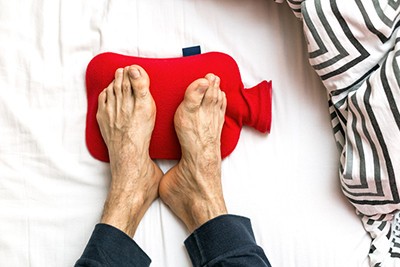It’s a common complaint: “My feet are always cold!” You might experience this particularly at night or in cooler environments. While occasionally having cold feet is often normal, persistently cold feet can raise concerns about your health. Let’s explore the common reasons behind cold feet and when it might be a signal to seek medical advice.
Our bodies are designed to maintain a stable core temperature. When your core temperature drops, your body prioritizes keeping your vital organs warm. To do this, blood vessels in your extremities, like hands and feet, constrict. This natural response, called vasoconstriction, reduces blood flow to these areas, which can lead to them feeling cold. People with less body fat may notice this effect more as they have less insulation.
 Close-up of feet sticking out from under the covers in bed, illustrating cold feet at night.
Close-up of feet sticking out from under the covers in bed, illustrating cold feet at night.
However, consistently cold feet could indicate underlying health conditions. One such condition is Raynaud’s syndrome. In Raynaud’s, the small blood vessels in your fingers and toes overreact to cold or stress. This overreaction causes them to narrow excessively, dramatically reducing blood flow. During an episode, your feet might turn white or blue, feeling intensely cold and numb. As blood flow returns, they may then turn red and throb or tingle.
Another potential cause of chronic cold feet is reduced blood circulation in the extremities, often linked to peripheral artery disease (PAD). PAD is frequently caused by atherosclerosis, a condition where fatty deposits build up in your arteries, narrowing them and restricting blood flow. If you have atherosclerosis affecting the arteries in your legs and feet, you might notice your feet are persistently cold. Other signs of PAD include changes in foot color – they may appear bluish or purplish when you’re sitting and pale when you elevate them. You might also experience pain in your calves when walking. Doctors can often diagnose PAD by checking the pulses in your feet and legs.
Nerve damage, also known as neuropathy, is another medical reason for cold feet. In this case, the sensation of cold isn’t necessarily due to a temperature drop in your feet themselves. Instead, damaged nerves misinterpret or misfire temperature signals, leading to a perception of coldness. While your feet might not actually feel cold to the touch, you may experience numbness, tingling, or a pins-and-needles sensation along with the feeling of cold.
While occasional cold feet are usually not a cause for concern, persistent cold feet, especially when accompanied by color changes, pain, numbness, or other symptoms like leg pain during walking, should be evaluated by a healthcare professional. They can determine the underlying cause and recommend appropriate management or treatment.